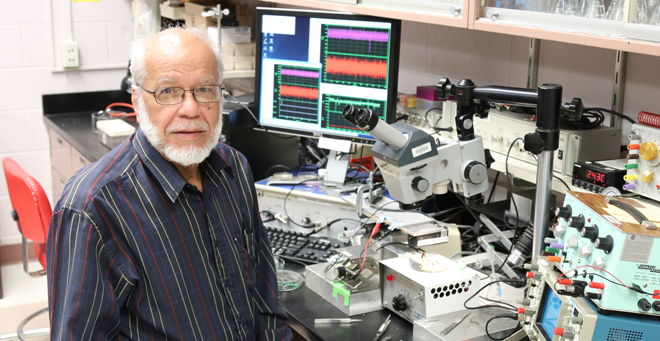 |
|
|
Raúl Padrón, PhD |
Raúl Padrón, PhD, senior research scientist in radiology, has been elected to the National Academy of Sciences as a foreign associate and will be honored at the 156th Annual Meeting, April 27-30, in Washington, D.C. The National Academy of Sciences is a private, nonprofit society of distinguished scholars. Established by an act of Congress signed by President Abraham Lincoln in 1863, it is charged with providing independent, objective advice to the nation on matters related to science and technology. Scientists are elected by their peers to membership in the NAS for outstanding contributions to research. As the role of science has expanded in the United States, the National Academy has grown to include the Institute of Medicine, the National Academy of Engineering and the National Research Council.
Dr. Padrón arrived at UMass Medical School last year with a long record of scientific accomplishment. His career began at the Universidad Central de Venezuela, where he earned a degree in electrical engineering, and at the Venezuelan Institute for Scientific Research, where he received a master of science in biology and a summa cum laude PhD in biophysics and physiology in 1979. He was a postdoctoral fellow in muscle structure and function at the MRC Laboratory of Molecular Biology (Cambridge, U.K.) in 1980, and joined the Venezuelan Institute for Scientific Research in 1983, where he founded the Center of Structural Biology. He was an International Research Scholar of the Howard Hughes Medical Institute (HHMI) from 1997 until 2011, and was elected as a member of the Latin American Academy of Sciences (ACAL) in 2002 and the World Academy of Sciences (TWAS) in 2004.
Padrón is interested in the structure and function of the myosin filaments of muscle, which are responsible for muscle shortening and development of force. An important focus of his work is how intramolecular interactions within myosin molecules bring about muscle relaxation, and how mutations in myosin lead to inherited cardiac muscle diseases.
Roger Craig, PhD, professor of radiology, and Padrón started collaborating in 1980 when they were postdoctoral fellows at the MRC Laboratory of Molecular Biology in Cambridge, U.K. The project was to solve the structure of myosin filaments, and they started with the muscles of tarantula legs. They have been collaborating ever since. The most notable outcome of their collaboration was the unexpected finding of the intramolecular interactions within myosin molecules, which they and their collaborators found by cryo-electron microscopy of tarantula thick filaments, published in Nature in 2005. Subsequent work suggests that this interaction is present in all muscles, including those of humans. They are continuing their long-term collaboration, aiming to solve the atomic structure of myosin filaments by cryo-EM at the UMMS Cryo-EM Facility.
Padrón is one of six members of the National Academy of Sciences at UMMS, including:
- Roger J. Davis, PhD, Howard Hughes Medical Institute Investigator, the Arthur Smith Chair in Cancer Researchand chair of molecular medicine
- Nobel laureate Craig C. Mello, PhD, Howard Hughes Medical Institute Investigator, the Blais University Chair in Molecular Medicine, distinguished professor of RNA therapeutics and professor of molecular medicine
- Victor R. Ambros, PhD, the Silverman Chair in Natural Sciencesand professor of molecular medicine
- Melissa J. Moore, PhD, professor of RNA therapeutics; and
- Michael R. Green, MD, PhD, the Lambi and Sarah Adams Chair in Genetic Research,chair and professor of molecular, cell & cancer biology, professor of molecular medicine, director of the UMass Medical School Cancer Center, and co-director of the Li Weibo Institute for Rare Diseases Research.
Dr. Green is also a member of the National Academy of Medicine, as is Robert H. Brown Jr., DPhil, MD, the Leo P. and Theresa M. LaChance Chair in Medical Research, professor of neurology and director of the Program in Neurotherapeutics.